Two games in, and the Hogs’ offense is rolling. Despite facing two fiesty defenses, the Razorbacks have scored 75 points through two games and lead the SEC in both rushing and passer efficiency.
In addition to our advanced stats, we also have play logs. We know every formation, concept, and playcall the Hogs’ offense has used this season, and we can use it to learn more about the Razorback offense: what they do well, what they want to do, and what they’re working on.
Today’s post will focus on the following:
- An quick overview of Arkansas’ offensive philosophy under Kendal Briles
- A review of the Cincinnati game with a focus on some of the base concepts in Arkansas’ offense
- A review of the South Carolina with a look at some new concepts we saw in that game
- Recap of the good and bad so far
This is all possible thanks to Clark Brooks, aka SEC Stat Cat, who publishes game scripts for every SEC team in every game. It’s important to note that he uses standard terminology: each team is different, so Arkansas almost certainly does not call these plays anything like what you’ll see them called here. That isn’t really the point. The point is to get a better look at what’s working and what isn’t, and what the Hogs are trying to do on offense.
Arkansas’ offensive philosophy
It’s actually important to start there: what is Arkansas trying to do on offense? Sam Pittman didn’t just hire Kendal Briles because he pulled his name out of a hat. Here’s some background on the Razorback attack.
Art Briles turned Baylor into a powerhouse by doing one thing really well: putting maximum pressure on the defense, which has to stop beefy power run games and track star receivers going deep with the same 11 guys. Few offensive minds in modern football were as good as Art Briles at stretching the defense between its need for size and its need for speed, through both scheme – a power run scheme combined with lots of deep shots – and personnel: Briles wanted huge offensive lines and extremely fast receivers. The “huge offensive lines” part is probably what caught Pittman’s attention when he was looking around for offensive coordinators.
Arkansas’ offense isn’t identical to what Baylor ran with Robert Griffin III and others. RPOs have developed and gained popularity, for example. And defenses adapted to various spread offense innovations of the 2000s and early 2010s, with newer trends like quarters, base nickel, and tite fronts becoming ubiquitous.
Kendal Briles learned a lot about adapting his offense during his year under Lane Kiffin at FAU. Kiffin comes from a West Coast background, but playcalling, particularly using plays to set up other plays, is considered his greatest strength. Kiffin taught Briles how to always be building toward something with each call. The current Arkansas offense is much more flexible than the old Baylor offense. It’s less reliant on deep shots and uses a variety of influences, including West Coast and pro-style concepts. But the basic objective is still the same: if the defense is too big to run over, beat them with speed, and if they’re too fast to throw over, beat them with size.
The Hogs’ playcalling under Briles is generally 40-40-20 between RPOs-called runs-called passes on standard downs. In passing situations, the number of called passes obviously increases, but the Hogs still try a lot of RPOs on passing downs, which is why they have a higher-than-average run rate on passing downs.
Recent posts
- Box Score Breakdown: Arkansas 89, Michigan 87
- Matchup Analysis: UTSA
- Box Score Breakdown: Arkansas 76, Miami 73
- Matchup Analysis: Miami
- Matchup Analysis: Illinois
Cincinnati
Let’s walk through both games. Best I can tell, here are the basics of Arkansas’ gameplan heading into the Cincinnati game:
- Lots of at-the-snap motion. Cincinnati loves to move around right before the snap on defense, so the Hogs wanted to retake the initiative by having receivers in motion when the ball is snapped. That puts the Bearcats back on the defensive as they have to react.
- Set the edge with the run and pass. Cincinnati plays a 3-3-5 defense. Their lack of size up front is a concern, so the Hogs knew Cincinnati would go with a “tite” front (all three defensive linemen lined up inside the tackles) to try and stop the run. The downside of a tite front is that defensive linemen will have a hard time being edge defenders because of how far inside they have to line up, so the defense is vulnerable to outside runs and horizontal passes.
- Give Jefferson lots of checkdown options. Cincinnati’s pass defense was elite last season, and the Hogs are rebuilding at receiver. Briles always wants to take some shots, but with so many unknowns, he wanted to make sure Jefferson had options to check down if the shot play isn’t there, using Trey Knox and running backs as receivers.
Interestingly, Arkansas mostly failed on all three of these objectives, which is why the offense took so long to get going. The adjustments the Hogs made helped them win the game.
RPOs with at-snap motion
Arkansas’ first three plays from scrimmage were all RPOs with at-the-snap motion. The Hogs start the game with a solo slant attached to an inside zone run, with Haselwood coming on jet motion. Jefferson is reading the strong safety to his left. When his first step is in to play the run, Jefferson pulls the ball and throws the slant:
H Jet 4 RPO X Slant
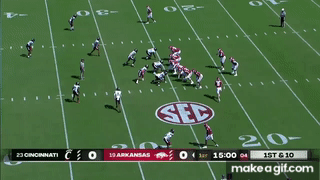
I’ll try to add play names wherever I can. Here’s what this one means:
- H Jet: the H-receiver (slot receiver) is coming on jet motion before the snap
- 4: the run direction; the running back is going through the 4-hole, which is over right tackle
- RPO: it’s an RPO
- X Slant: the route tag; the X-receiver (split end) is running a slant, plays might have one route tag, several route tags, or none at all
Cincinnati, probably expecting an RPO, blitzed. Note Trey Knox, on the left side of the line, holding up well in pass protection. That’s really impressive for a converted wide receiver.
The Hogs go hurry-up, and use the same formation for the second play, except now Haselwood is motioning left-to-right. While he was a distraction on the first play, now he’s in position to run a wheel route, with Landers running a stick route to hold the cornerback in.
This is a potential shot play if the defender doesn’t get over fast enough, but he does, and Jefferson’s throw is not accurate:
H Shoot 2 RPO X Stick Wheel
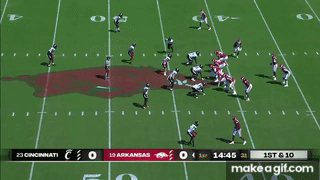
Haselwood was kind of open for a backshoulder throw, but Jefferson probably could have done better by either throwing or pump-faking to Knox, as Cincinnati had only one defender to deal with Jefferson and Knox.
After two plays, the Hogs had to feel pretty good about their gameplan, as they had good looks on the first two plays. Unfortunately, the Bearcats clamped down on these looks, and the Hogs only had one more successful RPO with in-snap motion for the rest of the game: a 6-yard completion to Landers early in the fourth quarter.
Getting to the edge
Arkansas continues to try and establish its gameplan, now combining the first and second parts. On the third play of the game, the Hogs motion Rocket Sanders out and give Jefferson the option to run a QB power behind Beaux Limmer or throw the swing to Sanders.
The Hogs are probably hoping that the safety who comes down into the box is going to go with Sanders – that would signal to Jefferson to run the QB power – but he doesn’t. Cincinnati plays this perfectly:
Frank 5 Q Power RPO Swinger
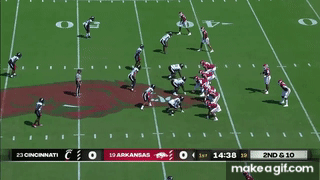
The blitz messes everything up, but the Bearcats’ nickel also does a great job of recognizing the play and trying to bulldoze past Haselwood, preventing the swing pass. Jefferson does nicely to not take a sack. Blitzing an RPO is a good way to mess it up, since the offensive line is run-blocking.
Cincinnati’s defense did an excellent job of setting the edge in this game, which took away a lot of what Arkansas wanted to do. After that swing pass, the Hogs tried one more – on the third drive – which lost two yards. Briles did not call another swing pass or similar edge passing concept for the rest of the game.
Running on the edge led to similar problems. Again, the Hogs wanted to run outside zone to take advantage of the Bearcat defensive line’s narrow splits, but Cincinnati’s back end was so good at stringing those plays out:
4 Outside Zone Read
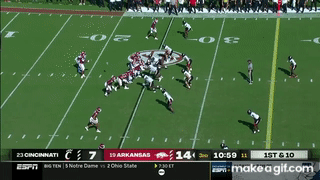
For the game, Arkansas’ nine outside zones averaged just 2.6 yards per rush with 22% success (2 of 9 were successful). Six were called in the first half, with just three in the second half and none after the 6:30 mark of the third quarter.
Running up the middle
The Hogs actually ended up breaking Cincinnati’s “tite” front, but not the way they had planned. The Bearcats were too smart and too quick on the edge on set plays, but they struggled when Razorback ballcarriers improvised, as their back end defenders had been drawn to the inside.
ESPN’s crew showed an interesting graphic in the third quarter:

This graphic seems to imply that Arkansas was having more success running outside than inside. But there’s a problem: the two plays diagrammed below were recorded as “outside” runs, when they were clearly supposed to go inside.
In both, the ballcarrier bounced it outside. Here was the longest run of the game:
2 Inside Zone Read
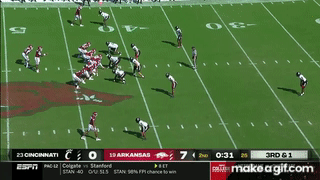
This was simple inside zone read on 3rd-and-1. The hole is there for Sanders to get the first down that way, but he must have seen Knox setting up a second-level block on the outside, so he bounced it out. The Bearcats have no one to deal with Sanders bouncing outside so he gets a huge gain.
Jefferson did the same thing on a simple split zone where the edge defender was drawn in by action to the inside:
Y Shoot 2 Q Split
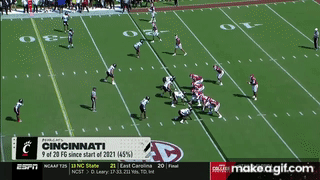
Traditional inside zones where the back didn’t bounce also gained plenty of yards, though they didn’t produce any big runs. Not counting the the final, run-out-the-clock drive, the Hogs ran 17 inside zones, averaging 8.4 yards per carry, +0.26 EPA/Rush, and 41% Success Rate.
If you revisit that ESPN graphic from earlier, Arkansas actually had 11 outside runs for 55 yards (5.0 per carry) and 9 inside runs for 91 yards (9.1 per carry) in the first half. Quite a different story, don’t you think?
Dropback passing
While Arkansas’ ability to successfully get yards on inside runs kept the ball moving, the Hogs broke the game open once the dropback passing game was figured out.
Dropbacks here are passes that are not RPOs, not play action, and not screens. Arkansas’ first four dropback attempts were unsuccessful. The first was on third down on the opening drive, when the Hogs just hoped Haselwood could break a tackle on a little stick route, and he couldn’t.
The second dropback attempt again was on third down. The Bearcats rush five and the blitzing linebacker is able to sneak inside of Limmer to pressure Jefferson:
80 Y Cross H Pivot
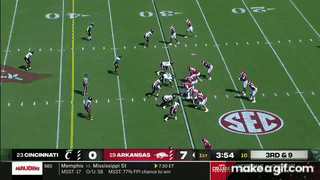
Continuing the theme from above about edge passing, you can see how quickly Cincinnati swarms on Sanders after the ball goes outside. It’s clear that’s not a viable option against this defense.
So Briles changes things up, deciding not to sneak the running back into the flat anymore. Arkansas’ next four dropback passes all involved extra pass protectors.
Here’s the the first, where Sanders stays in to help protect against a five-man rush:
81 Mesh Dagger

When the Bearcats brough five rushers, they did not expect Jefferson to have that much time to throw. Good job by the line and the quarterback to make that play work.
Arkansas’ last two dropback attempts in the first half were both max protect (tight end and running back staying in to block). That leaves only three receivers in the formation. Both were incomplete. The Hogs used a lot of max protect passes back in 2020 when Feleipe Franks was the quarterback and the offensive line was much worse, but they don’t seem to be as well-suited for Jefferson.
In the second half, Jefferson was 5 of 6 for 82 yards and two touchdowns on traditional dropback passes. The two sacks Jefferson took came on an RPO and a max protect pass.
The Hogs only put five receivers in the pattern on two plays in the second half. Here’s the first:
80 Y Shock F Fade
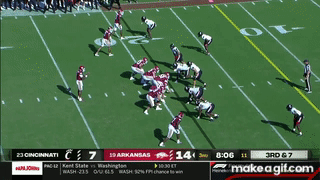
And here’s the second:
80 Poker Swap X Sluggo
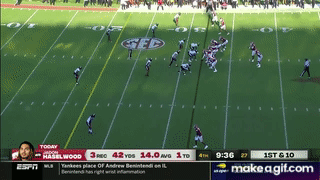
Both of these are excellent playcalls. On the touchdown to Haselwood, Cincinnati decides to blitz against an empty set, so the Hogs smartly call a slot fade, telling Jefferson to just get a catchable ball in the air and give his guy a chance. Notice left tackle Luke Jones, who didn’t have a great game overall, just barely manages to land his block, though he gets the job done here.
On the second, the Hogs have basically gone two quarters at this point with every pass having at least one extra pass protector, so sneaking Knox (and Sanders, bottom of screen) out of the backfield totally fools the Bearcats, who don’t cover either guy.
Cincinnati had to keep blitzing in order to disrupt the RPO game. Once Arkansas figured out the best way to throw against the blitz, the offense took off.
Special passes and screens
The Hogs also had two “special passes”, basically trick plays. There was the pop pass for a touchdown to Knox and the double-pass with Malik Hornsby that Hornsby ended up running for a 13-yard gain. There wasn’t really anything fancy on either one: the Bearcats weren’t actually fooled either time, but both were still successful.
There was also a slip screen to Rashod Dubinion that gained 29 yards. So the Hogs were 3 for 3 on special passes.
South Carolina
We’ll spend less time on the South Carolina game, as most of Arkansas’ base stuff appeared to work much better.
Running outside
Given the issues running outside against South Carolina, the Hogs attempted very few outside zones early in the game. Instead, they tried a new outside run we didn’t see against Cincinnati: the Bash Read. Here was its best rep:
5 Bash Read
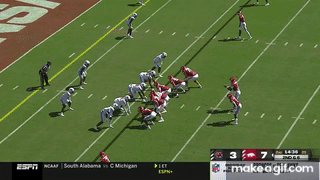
This is a read, so the playside defensive end is unblocked. If he stays inside (as he did), Jefferson is handing off. If he plays the running back by stepping outside, Jefferson can keep up the middle. Here’s what that looks like:
Falcon Return 5 Bash Read
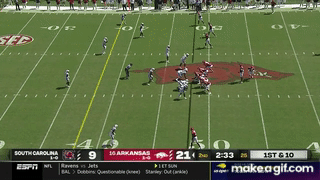
The Hogs ran all versions of Bash Read six times for 44 yards, with four of six reps successful.
While that’s good news, the bad news is that Outside Zone is still an area of concern. After a bad game against Cincinnati forced the Hogs to largely abandon them, the numbers against South Carolina weren’t great: 16 rushes, 66 yards (4.1 per carry), -0.13 EPA/Rush, 31% Success. The Hogs were able to run outside with those Bash Reads, plus an end around with Landers that gained six yards. They also attached a tap pass (called a Utah concept) to an outside zone look and ran it twice against South Carolina:
8 F Utah Fake 4 Zone
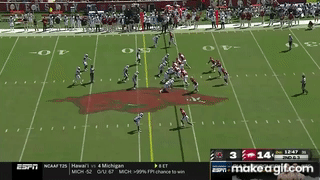
So while Briles is working on finding ways to get around the edge, the Hogs need to get better at running that core outside zone.
Power series runs
The Hogs also ran nine total inside powers – up from three against Cincinnati – and they totaled 25 yards. Most were some variation of a Dive concept, and most were at the goal line.
Here’s one of the few that wasn’t:
3 Dive
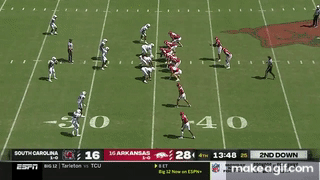
The difference between this play and a normal inside zone (that the Hogs called 19 times against South Carolina) is how it is blocked. In zone schemes, the offensive linemen are responsible for blocking an area (or “zone”) and will move into the second level if there is no defender in their zone. You can often identify zone blocking when you see all five linemen move in the same direction at the snap.
In a gap scheme, linemen will use leverage and “down block” any defender that’s covering them. Gap runs are simple for offensive linemen to execute, but require patience by the ballcarrier to work properly. They are also vulnerable to unique defensive fronts, as every gap run looks different depending on how the defense aligns. Zone runs are simpler and more predictable, but they require good vision by the back, as there are often cutback lanes available (hence Sanders’ big run against Cincinnati from above).
Another gap scheme run we’ve seen a couple times in each game is the Belly Counter Read. Here, Jefferson hands it off, but he can also keep and run the other way, as the left tackle has peeled off to block the defensive end:
5 Counter Read
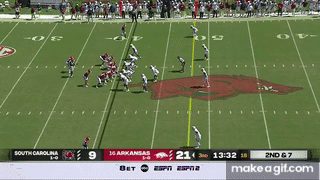
Dropback passing
Through two games, the Hogs are very strong on traditional dropback passes. About half of their 29 regular dropbacks have been successful with more than seven yards per play. One interesting tidbit is that the Hogs have run some version of Y-Cross – a classic zone-beater – three times this year, and Jefferson has checked down to Knox or Sanders all three times.
What’s working, and what isn’t
Okay, so where are now after two games?
The good
Dropback passing. Through two games, Jefferson has 29 traditional dropbacks, and the Hogs are sitting at 7.3 yards per play, +0.28 EPA/Play, and 45% Success. Given the quality of the two secondaries Arkansas has seen, that’s very good. Jefferson is checking down a lot, but that’s okay. Building rapport with receivers is one of our keys to the game against Missouri State.
Special passes. The Hogs have called seven “special” passes so far this year. These include the Hornsby double-pass, three tap passes (technically called Utah concepts), the pop pass for a touchdown to Knox, and two shovel passes. All seven have been successful and are averaging 9.4 yards per play.
Inside runs. Arkansas’ 36 inside zones are sitting at 6.0 yards per play, +0.24 EPA/Play, and 50% Success. Opponents aren’t stopping them at all, and they’ve been instrumental to keeping the offense moving.
The bad
Outside zones. The Hogs’ 25 outside zones are now at 3.6 yards per play, -0.31 EPA/Play, and 28% Success. Not ideal. The six Bash Reads infused some life into the edge rushing attack, as have the three tap passes and one end around, all of which were successful. But the outside zone is part of the bread-and-butter of the offense, so it would be nice to see it work.
All-around explosiveness. The gameplan probably restricted big play attempts for both games, but so far, the Hogs aren’t hitting many big ones. The more efficient run game is helping the offense build long drives compared to last year, but lightning-quick drives should be in the mix too. The vertical passing game is needed to keep the defense honest, so let’s see if the Hogs work on it this weekend.
We will continue to periodically update play logs as the season progresses to keep an eye on shifts in strategy and new plays.
The latest from Fayette Villains, straight to your inbox
Enter your email to subscribe and receive new post alerts and other updates. You can unsubscribe at any time.